STEEPLES IN THE TEXAS SKY
Published by the La Vernia News on March 20, 2014
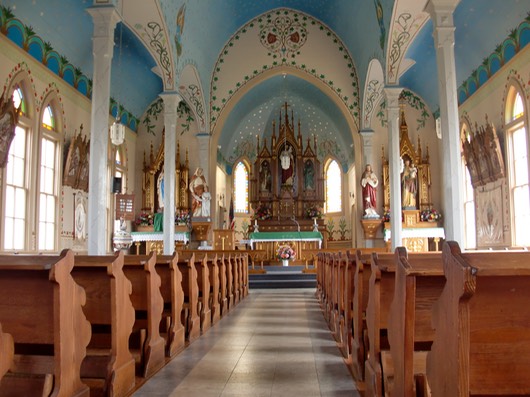
Eighty-nine miles from La Vernia in the Schulenburg area are four churches built by Czech and German immigrants over 100 years ago. At first glance, they appear to be typical turn-of-the-century structures, but once you step through the door and get the first glimpse of the profusion of color inside, you immediately know why they are included in the “Twenty Painted Churches of Texas.”
EARLY BEGINNINGS: The first Europeans in this area were members of the LaSalle Party in the1680s. LaSalle was an explorer and a fur trader; he made four major expeditions between 1666 and 1687, from an area near Quebec all the way to the Gulf of Mexico. As he traveled across this great wilderness, he claimed the land for King Louis XIV of France. There was also evidence that many Indian tribes including the Tonkawa and the Comanche made this land their home as well. In the 1830s, a group from Tennessee settled here thanks to the Mexican Land Grants. Unfortunately, disease wiped out most of the settlers and by the time the Czechs arrived in 1856, all that was left were a few grave markers.
Everyday Journeys
Harry and Linda Kaye Perez
What brought these settlers to this area was land – it was plentiful, fertile, and cheap. Struggling to survive in this new wild country, the desire to preserve their culture and their religion drove them to build houses of worship to resemble those of their homeland. Lack of raw materials led them to use what they had - wood and paint, covering almost every inch of the interior walls and ceilings with painted murals and stenciled designs.
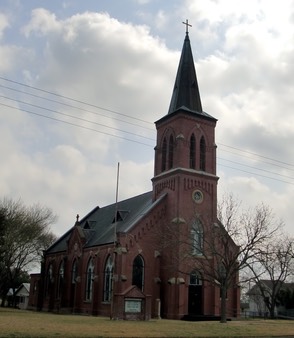
TOURING THE CHURCHES: Your first stop should be at the Schulenburg Chamber of Commerce at 618 Main Street. They can provide all the information you need to enjoy your visit. From the Chamber office, we visited the High Hill Church, followed by Dubina, then Ammannsville and finally on the way home, stopped at Praha near Flatonia. Total distance between all churches is approximately 28 miles.
SAINTS CYRIL AND METHODIOUS CHURCH, Dubina: In 1856, a small group of Czechs set out from their homeland on a 14-week journey across the Atlantic to the Port of Galveston in a small sailboat named the Elizabeth. Aboard were families with names of Marak, Holub, Muzny, Haidusek, and Kossa. From the coast, these settlers made their way west by the fastest mode of transportation - the covered wagon. They arrived in November of that year and named their new home Dubina, meaning “oak grove” in their native language. By 1877, the first church was built, but was destroyed by a hurricane in 1909. A new church was completed in 1911 and the interior was completed with frescos and stenciled designs.
ST. MARY’S CATHOLIC CHURCH - Nativity of the Blessed Virgin Mary at High Hill: In1860, several families from Austria made that same journey across the Atlantic to Galveston and on to Dubina. After a couple of days of rest, they continued on and settled just a few miles west of Dubina. They named their new home Blum Hill, later changed to High Hill. The current church, built in 1906 on the same site as two previous churches, is known as the Queen of the Painted Churches. This red-brick structure is a beautiful blend of Gothic and Revival with Victorian, German and Czech-Moravian influences as well. Inside is an elaborate altar, Stations of the Cross imported from Italy and a reproduction of Michelangelo’s Pieta. Stained-glass windows and the soft blue and gold leaf dome is an incredible site, especially when lit by the afternoon sun. www.stmary-highhill.com
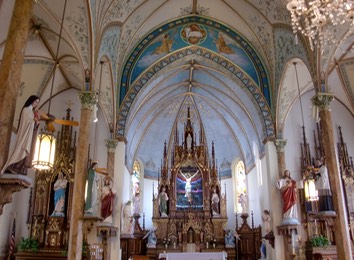
ST. JOHN THE BAPTIST CATHOLIC CHURCH, Ammannsville: In 1870, ten years after the settlement at High Hill, the Ammanns family, farmers by trade, started the community of Ammannsville, five miles north of the original settlement of Dubina. The town had a blacksmith shop, a bank, a cotton gin, a doctor, a Justice of the Peace and even a baseball team. For almost 20 years, citizens of Ammannsville travelled to neighboring parishes, most likely Dubina, to attend mass. Finally in 1890, construction began on the St. John the Baptist Catholic Church. Like Dubina, their church was destroyed by the hurricane of 1909. The church was rebuilt, but eight years later burned to the ground. In 1917 the present church was completed on the same site.
ST. MARY’S CHURCH, Praha: Our final stop was St. Mary's Church in Praha, close to Flatonia. This area was originally named Mulberry, but the Czechs who settled here in 1858 changed it to Praha in honor of their homeland’s capital, Prague. The stone-exterior church was built in 1895; the predominate color inside is blue with painted wildflowers and angels. www.stmarys-praha.com
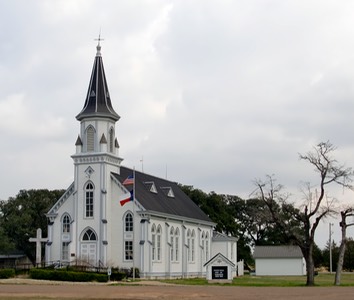
ENJOY THE DRIVE: The road from High Hill to Dubina and on to Ammannsville is a beautiful scenic drive and takes you across the single lane Piano Bridge. Once this was an all-wooden bridge and folks say that when you drove across it, the wooden planks sounded like someone playing a xylophone. As beautiful and unique as these churches are, the drive to visit them is a treat in itself. And, as good as the directions are on the map to locate each of the Painted Churches, sometimes all you have to do is look just above the treetops; you will see the church steeples in the Texas sky.
Find out more
Schulenburg Chamber of Commerce:www.schulenburgchamber.org
St. Marys at High Hill: www.stmary-highhill.com
St. Mary's, Praha: www.stmarys-praha.com
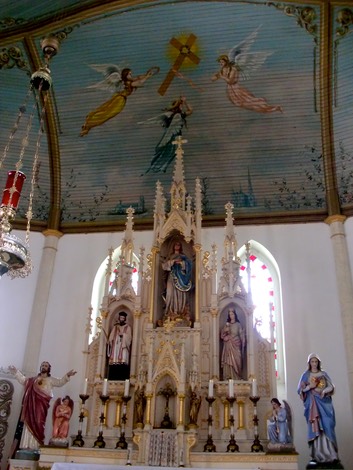
Hints:
Avoid visiting during Holy Week (April 13-April 20, 2014)
Purchase a $4.00 map from the Schulenburg Chamber of Commerce. It will save time and gas locating each of the Painted Churches.
If you encounter a tour group, be patient. They only spend a few minutes at each church.
Pack a picnic lunch and enjoy the beautiful countryside; listen to the breeze blowing through the trees, announcing that springtime is approaching.
______________________________________________________